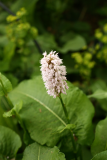Additional notes (click to expand)
Bistorta officinalis Delarbre
Family: POLYGONACEAEGenus: Bistorta
Species: officinalis Delarbre
Common names: Bistort, Snakeweed, Easter Ledges
Pharmacopoeia Londinensis name: Bistorta sive serpentaria
Distribution summary: Europe, N.& W.Asia
Habit: Perennial
Hardiness: H7 - Very hardy
Habitat: Damp meadows, sandy streamsides
Garden status: Currently grown
Garden location: Pharmacopoeia Londinensis 1618 'Roots' (HSE 2)
Flowering months: June, July, August, September
Reason for growing: Medicinal
.JPG)

